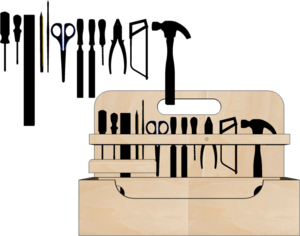Primary Toolboard - A2
From DT Online
Introduction
Using only a few additional skills and techniques, together with some everyday materials and 'found objects', children can work in safety to produce an almost limitless variety of constructions and working models to enrich their learning generally.
At its most basic, the list of equipment required, can simply comprise: pencil, ruler, pencil sharpener, scissors, paper punch, stapler, junior hacksaw and a small clamp-on vice, together with PVA glue, paper clips, bulldog clips, wooden clothes pegs and adhesive tapes.
This basic tool kit can be supplemented with other equipment, some of which is for adult use or for use only under direct adult supervision, such as: Craft Knife, Precision Mitre Saw, Coping Saw, Hot Glue Gun, Low Voltage Soldering Iron, Hand Drill.
All Design and Technology tools, equipment and materials should be well organised and stored in a way which makes it clear which is for general use, which must used only under direct adult supervision, and which is for adult use only.
A2 Toolboard
One storage solution for Design and Technology tools and equipment is to rack them on Toolboards. These help make it clear what is available, where tools and equipment can be found - and to where they should be returned after use.
A Toolboard approximately A2 size can accommodate a wide selection of tools and equipment, including multiple copies of some (e.g. junior hacksaw) to allow for paired or group working. A larger size would be difficult to handle and find space for.
A wall-mounted Toolboard containing a basic D&T Toolkit, which is available for general use by pupils, can be fully labelled and kept on permanent display as a continuing prompt and reminder of what is available for use.
Toolboards containing a basic D&T Toolkit can be duplicated for larger group work or supplemented by others containing extra tools and equipment needed for a particular topic or those to be used only under direct supervision.
Toolboard Construction
The Toolboard itself can be made quite simply by cutting out from a sheet of 8mm to 12mm thick plywood and wall-mounted. The tools are held within purpose-made Toolblocks which makes checking and managing their use easier.
Provision can be made to attach various removable Toolboxes. These can be used: to contain some materials which are always available for general use; to contain additional tools and equipment or to contain resources for a particular topic.
A simple mounting 'button' can be made by bolting a repair washer against a MDF, or similar, spacing disc. The spacing disc should be slightly thicker than the rear panel of the Toolbox, holes are drilled through the rear panel (e.g. with a Hole Saw) larger than the washer and all arranged such that the bottom of the box is level with the bottom of the Toolboard when fixed (i.e. top of spacer = top of hole in rear panel).
Toolblock Construction
Some dimensions are given for a typical Toolblock suitable for an A2 size Toolboard designed to accommodate a commonly used Primary D&T Toolkit. The range of tools, and therefore dimensions, should be varied, of course, to suit any deviation from this norm.
Additional, shorter Toolblocks can be added both to support shorter tool lengths and to provide additional guidance to long slim items (e.g. rulers).
Spacing blocks are cut to length (e.g. using a Precision Mitre Saw) and glued either side of a central plywood 'spine'. The Toolblock is completed by gluing other plywood strips to each side and any holes drilled after this 'sandwich' assembly. This construction avoids the use of any specialised tools or techniques.
Shadow Board
Toolboards can be enhanced by the addition of 'shadows' or silhouettes of the various tools. Together with good labelling of tool names this can assist in tool recognition - and provide a useful shape matching experience.
Note:
The Toolboards are shown with a natural timber finish but painted in suitable colours may be preferred. Also, the Toolboxes are illustrated with through Dovetail Joints but any corner joint, including simple screw and glue, can be used.
Primary schools linked to a neighbouring secondary school, may find that students there would interested in designing and constructing tool storage systems as a group activity, and would be able to manufacture them using the extensive D&T workshop facilities that most have.




